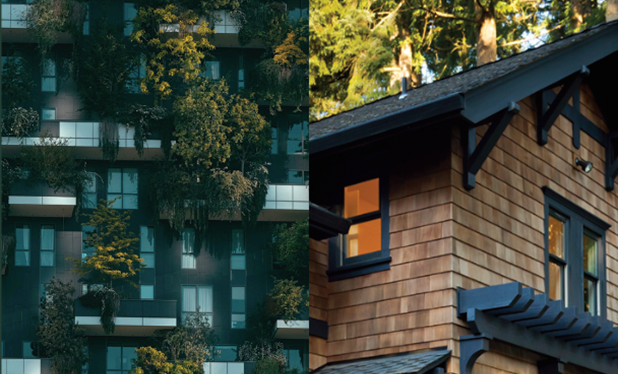Counterflashings are critical components of steep- and low-slope roof systems. They prevent rainwater from migrating behind underlying base flashings, the primary means of protecting roof-to-wall interfaces. Yet all too often, counterflashings are incorrectly detailed and poorly installed. Problems range from insufficient overlap, exposed fasteners, shallow reglets, missing hook dams, ledges that direct rainwater back into the masonry wall and inappropriate material selection.
THE PIECES
When installing a proper counterflashing, there are several considerations. What follows is a list of key features of this seemingly simple detail with a focus on regleted counterflashings set into masonry walls, which often are used in historical steep-slope roofing. (Through-wall counterflashings, receivers and surface-mounted counterflashings are beyond the scope of this article as are counterflashings for use with cavity walls, thin stone or brick veneer walls, exterior insulation finish system walls, and concrete or precast walls.) Figure 1 illustrates the various components.
Reglet
Reglets (sometimes called raggles) are grooves, or slots, cut into masonry walls for the purpose of receiving the horizontal or reglet flange of counterflashings. Reglets typically are cut in horizontal mortar joints between masonry units to create a stepped pattern. Avoid cutting a continuous reglet through the masonry units parallel with the roof surface. This practice can expose the clay body of brick masonry units to moisture and create small fragments of masonry that are prone to cracking or breakage.
In addition, avoid vertical reglets because they typically require cutting through masonry units and tedious detailing of each counterflashing’s reglet flange and rarely are executed properly. Reglet layout must allow for adequate base flashing height parallel to the roof surface—4 inches minimum for a typical steep-slope roof. Too often, reglets are pre-cut one or two courses too low or cut directly through previously installed base flashings, effectively reducing the height and functionality of the base flashings. It is good practice for the design professional and contractor to meet and jointly mark the locations of counterflashing reglets using a marker, keel or tape, or by drawing on a photo after the meeting.
Laps
Establishing the correct lap of counterflashings over each other and over the base flashings is part of the layout process.
Counterflashings should:
- Lap each other a minimum of 4 inches to help prevent wind-blown rain from traveling laterally and bypassing the counterflashings
- Lap underlying base flashings a minimum of 3½ inches while extending to within ½ of an inch of the roof surface. (Editor’s note: NRCA recommends 4-inch-tall base flashings be lapped a minimum of 2 inches by counterflashings. NRCA recommends that counterflashings should not rest on the roof system and not extend lower than about 1 inch above the roof surface.)
If masonry units are large, you can minimize the overall size of the counterflashings by cropping their lower corners (see Photo 1).
Bottom edges
Hem the bottom edge of counterflashings for stiffness and neatness. At the laps, the hems can be loose-locked together. This helps keep the counterflashings from displacing outward under wind and snow loads (see Photo 1).
Material selection
Sixteen-ounce cold-rolled copper (H00 temper) is perhaps the most common counterflashing material used in restoration work. It is easily formed; its soldering requirements are familiar to most sheet metal mechanics; and it can withstand prolonged contact with mortar materials. Given the vertical orientation of counterflashings, they will not be subject to erosion via flowing rainwater. As such, a heavier weight copper generally is not required. Sixteen-ounce soft copper (O60 temper) is more malleable than cold-rolled copper and may be advantageous when rock-faced masonry is present because it can readily be peened to conform to masonry’s profile (see Photo 1).
In the past, lead-coated copper frequently was used as a counterflashing material in lieu of copper to avoid staining of light-colored masonry, such as limestone and marble. Lead-coated copper has not been readily available since about 2011 when the U.S. stopped production because of environmental and health concerns associated with the lead coating. You can use tin-zinc alloy-coated copper instead of lead-coated copper, but it should not contact other metals or be placed downslope from other metals on a roof to avoid the potential for galvanic corrosion.
Avoid using lead for counterflashings because of its toxicity and tendency to creep and suffer from fatigue cracking over time. Stainless steel may be used as a counterflashing material, but it is difficult to work with because of its rigidity and even its least reflective surface finish is shiny and often aesthetically objectionable, especially for historical preservation work.
Reglet detailing
In mass masonry walls, reglet depth should be between 2 to 2½ inches though a depth of 1¾ to 2 inches often is more practical based on the size of mechanical grinding equipment (see Figure 2). Infrequently, it may be necessary to cut a counterflashing reglet directly in a stone masonry unit to provide for the necessary lap of adjacent counterflashings. This most often occurs at inside corners where horizontal joints between masonry units do not align and in rubble-stone walls where the coursing can be irregular. In such cases, it usually is prudent to limit reglet depth to about 1 inch.
The goal is to prevent bulk water that may have entered the masonry from migrating around and below the reglet flange of the counterflashing. In addition, the reglet must be cut deep enough to accommodate counterflashing securement and a durable depth of pointing mortar. Some prefer to fill counterflashing reglets with backer rod and sealant, but sealant tends to trap moisture within the masonry even when weeps are specified. Mortar, on the other hand, will allow the masonry to dry to the exterior. The narrow crack that may develop between the copper and mortar is of no concern as the small amount of water drawn into this crack via capillary action should not penetrate past the reglet flange of a properly detailed counterflashing.
Cut reglets so they are dead-level or slope slightly toward the exterior face of the wall. This prevents directing rainwater into the masonry. It may also be necessary to bevel the lower outside edge of the reglet or grind down projecting portions of masonry located behind the counterflashings to avoid creating a ledge in the counterflashing, which can pond water or direct water into the wall. To preclude a ledge from forming, it is important to make the reglet flange of the counterflashing the same depth as the reglet itself. If the reglet flange is too long, it will project from the face of the wall and create a ledge. Reglets that are too shallow, slope in toward the center of the masonry wall or create a ledge in the counterflashing should be redone (see Photo 2).
Securement
Counterflashings are secured in their reglets with lead wedges (rolled, 4-pound lead sheets) tapped into position to create a friction fit. Lead wedges typically are spaced 12 inches on center and a minimum of two per counter-flashing. If the counterflashing moves under hand pressure, add wedges as needed.
Fill reglets with mortar to match the color and texture of the adjacent joints. Alternatively, you can fill reglets with mortar to within about 1 inch of the surface of the joint; once the mortar cures, the remaining depth of the reglet can be filled with backer rod and sealant. As stated previously, the drawback of using backer rod and sealant is latent moisture within the masonry or on the counterflashing’s reglet flange cannot dry out through the reglet. Set wedges at the back of the reglet to allow for sufficient coverage (¾ to 1 inch minimum) of the mortar fill. Fill the portion of each reglet that will be covered by an overlying counterflashing before installing the overlying counterflashing (see Photo 3).
There should be no exposed fasteners in a properly detailed counterflashing. Fasteners—whether rivets, nail-driven expansion anchors, screws or nails—represent holes which, even if covered with sealant initially, will allow rainwater to penetrate eventually when the sealant fails and the fasteners loosen or displace over time.
Hemming counterflashing’s exposed edges provides rigidity and, when combined with loose locking the bottom edges at the laps, precludes the need for exposed fasteners in most cases. When counterflashings are more than 8 inches in height, exposed or concealed sheet-metal clips of a heavier gauge than the counterflashing can help keep the counterflashings in close contact with each other and prevent outward displacement (see Photo 4).
For 16-ounce copper counterflashings, 1¼-inch-wide clips may be fabricated of 20-ounce copper and either soldered to the underlying counterflashing or fastened to the masonry wall with appropriate fasteners, such as nylon nail-in anchors. In both cases, the means of fastening is concealed by the overlying counterflashing and the clips are folded around the vertical leg of the counterflashing and peened tight.
Changes in direction
The hook dam at the back end of a counterflashing’s reglet flange impedes the passage of stray moisture that may enter through the face of the reglet from progressing further into the masonry wall. At changes in direction in the counterflashing (such as inside and outside corners), it is important the reglet flange, including the hook dam, is watertight. At outside corners, the reglet flange may simply be slit, lapped and soldered. At inside corners, you should install a small gusset plate (square or rectangular-shaped piece of metal of the same type and thickness as the counterflashing) to complete the reglet flange and solder it watertight.
Aesthetics
On steep-slope roofs, counterflashings can be highly visible. As such, keep aesthetics in mind when designing and installing new counterflashings. For example, the bottom outside corner of the leading counterflashing (the first to be installed) may be radiused. As mentioned previously, you can hem exposed edges ¼ to ½ of an inch not only to provide stiffness but also to create clean, slightly rounded edges. Lastly, keep the steps between counterflashings as uniform as possible, especially where bed joints are regularly spaced as in brick masonry (see Photo 5).
OTHER TIPS
In addition, the following detailing items can help contribute to a successful counterflashing installation:
- When raking out counterflashing reglets with a grinder, make sure to maintain the existing mortar joint width and not widen the joint by removing masonry at the top or bottom of the joint.
- Grinders leave a radiused profile at the end terminations of reglets. To maintain the full depth of the reglet and avoid overcutting, rake out end terminations using hand chisels or pneumatic chisel guns.
- Rake out and repoint deteriorated mortar joints located behind existing counterflashings (and base flashings if these are being replaced, as well) before installing new flashings. After all, this may be the last opportunity to do so for many years.
- Counterflashings can do a good job protecting a roof system from water infiltration, but if there are numerous open mortar joints and/or cracked, spalled or displaced masonry units located above the counterflashings, it is likely too much bulk water will enter the masonry for the counterflashings to be effective. As such, it is good practice to undertake masonry restoration work above the counterflashings in advance of or at the same time as counterflashing replacement if possible.
- The bottom edge of any given counterflashing should be located slightly above the bottom edge of the overlying counterflashing at the laps. If it hangs lower, the aesthetics are poor and the exposed edge can trap debris and cause rainwater to back up into the base flashings, especially on lower sloped roofs. Loose locking the bottom edges of overlying counterflashings at the laps can largely resolve this issue.
Of course, if underlayments and base flashings at vertical walls are detailed incorrectly, the level of detailing and workmanship bestowed upon the counterflashings will be to little benefit. But, alas, these are issues for another article.
JEFFREY S. LEVINE is a roof consultant and associate principal in the Philadelphia office of Wiss, Janney, Elstner Associates.



